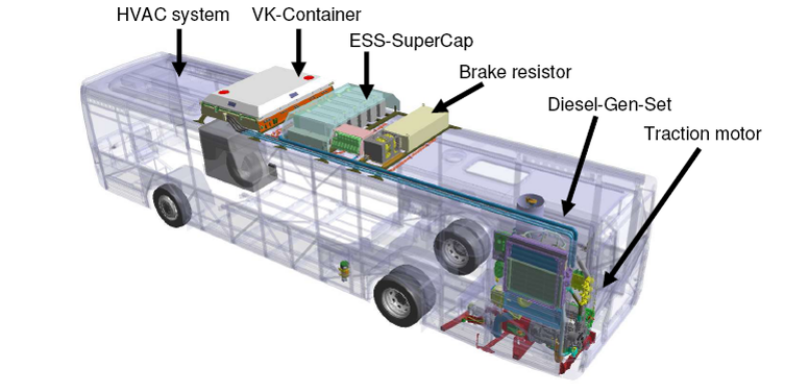Funding: | Agentschap NL |
Project: | Stille, schone en zuinige bussen in Twente |
Duration: | 2008 -2013 |
Project supervisor: | Regio Twente |
Project team CTS | |
Website: | www.lijn2gaatgroen.nl/ |
Abstract
TECHNOLOGY
ENGINE
The hybrid busses are driven by an electric engine rather than a diesel engine. The electric engine provides 120 kW. Electric engines provide this power at any engine speed, which is an advantage. Contrary to normal busses, these busses require no gear box; therefore the power loss from the engine to the wheels is limited. Besides, this electric engine is more powerful during acceleration than a diesel engine; therefore a smaller and less powerful engine can supply the same output!
BRAKING AND ACCELERATING
The engine that is used to drive the bus is used as a generator during the braking process. This operation is similar to the use of a generator on a bicycle. When you connect the generator to the bicycle wheel, more power is required to ride the bicycle and consequently the bicycle slows down. The power that is generated is temporarily stored in the hybrid bus in large batteries on the bus' roof. Later on, this spare power will be used to drive the electric engine during acceleration. All the power of the braking process of normal busses is lost, therefore hybrid busses process energy much more efficiently.
DIESEL GENERATOR
Hybrid busses can only cover limited distances on battery power. That is why a diesel generator was built into the bus, so as to supply extra power to the electric engine for longer distances. This does indeed imply that the hybrid busses use diesel and, therefore, expel CO2. However, the emission levels are far below those of normal busses. Normal busses typically use much diesel fuel during acceleration, whereas hybrid busses use battery power for acceleration. Moreover, the hybrid’s diesel generator can be used at the most efficient engine speed, which is why the hybrid’s diesel generator can be a lot smaller and therefore more economical and less noisy. In comparison: normal busses typically have 8 cylinders, whereas the hybrid’s diesel generator only requires 4 cylinders.
POWER DISTRIBUTOR
The power distributor is the key component of the busses, as it drives the electric engine, diesel generator and condensers. Its intelligent system knows the route and knows the actual location of the bus on the route. This way, the power distributor can determine the most efficient distribution of the battery’s power throughout the route, which ensures limited and highly efficient use of the diesel generator.
The power distributor will be updated during a 6-month test phase. The system will gradually become smarter and better, thus ensuring the hybrid bus to become cleaner, less noisy and more economical as time goes by.

